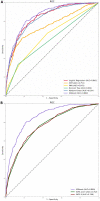Machine learning algorithm to predict the in-hospital mortality in critically ill patients with chronic kidney disease
- PMID: 37203863
- PMCID: PMC10201999
- DOI: 10.1080/0886022X.2023.2212790
Machine learning algorithm to predict the in-hospital mortality in critically ill patients with chronic kidney disease
Abstract
Background: This study aimed to establish and validate a machine learning (ML) model for predicting in-hospital mortality in critically ill patients with chronic kidney disease (CKD).
Methods: This study collected data on CKD patients from 2008 to 2019 using the Medical Information Mart for Intensive Care IV. Six ML approaches were used to build the model. Accuracy and area under the curve (AUC) were used to choose the best model. In addition, the best model was interpreted using SHapley Additive exPlanations (SHAP) values.
Results: There were 8527 CKD patients eligible for participation; the median age was 75.1 (interquartile range: 65.0-83.5) years, and 61.7% (5259/8527) were male. We developed six ML models with clinical variables as input factors. Among the six models developed, the eXtreme Gradient Boosting (XGBoost) model had the highest AUC, at 0.860. According to the SHAP values, the sequential organ failure assessment score, urine output, respiratory rate, and simplified acute physiology score II were the four most influential variables in the XGBoost model.
Conclusions: In conclusion, we successfully developed and validated ML models for predicting mortality in critically ill patients with CKD. Among all ML models, the XGBoost model is the most effective ML model that can help clinicians accurately manage and implement early interventions, which may reduce mortality in critically ill CKD patients with a high risk of death.
Keywords: Chronic kidney disease; critically care; intensive care unit; machine learning; mortality.
Conflict of interest statement
No potential conflict of interest was reported by the author(s).
Figures





References
-
- Copur S, Ucku D, Cozzolino M, et al. . Hypoxia-inducible factor signaling in vascular calcification in chronic kidney disease patients. J Nephrol. 2022;35(9):2205–2213. - PubMed
MeSH terms
LinkOut - more resources
Full Text Sources
Other Literature Sources
Medical
